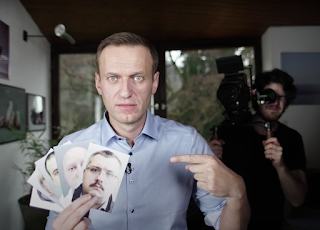 |
| Mark Rylance (right) in The Phantom of the Open |
Sunday, 3 July 2022
Sydney Film Festival 2022 - Film Review - The Phantom of the Open
Monday, 20 June 2022
Sydney Film Festival 2022 - Film review - Navalny
 |
| Alexei Navalny with photos of his would-be assassins |
With the assistance of online investigation agency, Bellingcat, all four agents were completely identified and shown to have stalked Navalny for a number of years. With key contact details sourced by Bellingcat journalist Christo Grozev during this film, Navalny was able to phone each of them direct until one agent, under the impression that Navalny was from within the security service, divulged most of the details of the operation. It's a stunning and breathtaking set of statements captured during the filming.
Also interviewed in the film are Navaly's wife, Yulia (a key person in her own right) their adult children, his media adviser and his chief-of-staff. Navalny is shown to be a charismatic lawyer who does not shy away from difficult questions and enjoys strong support in Russia. This makes him the key target for Russian president Vladimir Putin who refuses to even mention his name when asked. On arrival back from Germany, Navalny was arrested and sent to a penal colony facing 20 years imprisonment.
Given Putin's autocratic rule in Russia and the war again the Ukraine, this documentary could not be more pertinent. It is a must-see film to better understand the severity of the forces that Putin deploys in Russia.
Saturday, 18 June 2022
69th Sydney Film Festival - 2022 - in full swing
The Sydney Film Festival has returned in full for 2022 shaking off the effects of COVID-19 and being staged with 14 screens in multiple locations in Sydney including its main venue, the State Theatre with satellite film screenings located at Event Cinemas, Dendy Newtown, Palace Cinemas, Ritz Cinemas Randwick, Hayden Orpheum Cremorne, Casula Powerhouse and the Art Gallery of NSW.
Thursday, 16 June 2022
Sydney Film Festival 2022 - Film Review - Baz Luhrmann's "Elvis"
 |
| Austin Butler as Elvis Presley in Elvis |
For any film director the prospect of creating a biopic around a cultural icon such as the late Elvis Presley is always a daunting and high risk venture. Will the film do justice to its subject ? Will the legion of Elvis fans accept the representation of 'The King of Rock and Roll' as shown in the film ? Is there a proper balance between the undoubted talent of the man and his ultimate decline ? Australian film director, Baz Luhrmann has made a valiant and generally successful effort with this high production values film which focusses on the ascent of Elvis Presley from his initial performances to becoming a major international star prior to his decline in health and ultimate death in 1977. Presley was only 42 years of age.
Sunday, 22 May 2022
2022 federal election loss for the Liberal Party - where to now ?
 |
| Shutterstock |
- 76 seats are needed in the House of Representatives to become a Government
- Australian Labor Party on 71 seats
- Liberal National Party on 52 seats
- Other being Independents or The Greens have 15 seats
- Counting on postal votes and prepoll is continuing as over 6 million eligible voters used these methods.
- Liberal/National has 35.4 % (a fall of 3.29%)
- Australian Labor Party has 32.8 % (the ALP vote actually fell 0.5%)
- The Greens has 12.1 % (increased by 1.7%)
- One Nation has 5.0% (increased by 1.9%)
- United Australia Party has 4.3% (increased by 0.8%)
- Independents have 5.51% (increased by 2.14%)
- Others are at 4.95%
Archibald, Wynne and Sulman Prizes 2022
 |
| Journalist Laura Tingle by James Powditch |
Wednesday, 11 May 2022
Great Barrier Reef in Australia - coral bleaching increases in latest report
 |
| Aerial survey (c) Great Barrier Marine Park Authority |
- A total of 719 reefs were surveyed from the air between the Torres Strait and the Capricorn Bunker Group in the Great Barrier Reef Marine Park. Of these 654 reefs (91 per cent) exhibited some fomr of bleaching and a significant core of the central reef had severe or extreme bleaching.
- Coral bleaching seen from the air is largely consistent with the spatial distribution of heat stress accumulation with a larger proportion of coral cover bleached on reefs that were exposed to the highest accumulated heat stress this last Summer (late 2021 and early 2022)
- The waters around the Great Barrier Reef exceeded historical summer maximums for the hottest summer months with three distinct heat waves increasing thermal stress throughout the Central and Northern Great Barrier Reef.
- The 2022 Aerial Survey Map [shown above] illustrates the variation in bleaching observed across the reef in the second half of March. The aerial surveys were conducted by trained observers from the Great Barrier Reef Marine Park Authority and the Australian Institute of Marine Science.

